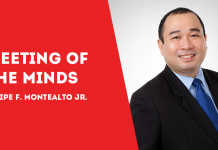
WITH President Rodrigo Roa Duterte’s (PRRD) announcement today that some parts of the country remain under “enhanced community quarantine” due to COVID-19, the country’s medical landscape and healthcare delivery have dramatically changed and adjusted to new working practices and shifts in demand.
In its website, Search Health IT defines “Telemedicine, also referred to as telehealth or e-medicine, [as] remote delivery of healthcare services, including exams and consultations, over the telecommunications infrastructure. Telemedicine allows healthcare providers to evaluate, diagnose and treat patients without the need for an in-person visit. Patients can communicate with physicians from their homes by using their own personal technology or by visiting a dedicated telehealth kiosk.”
It has been observed that some doctors have skepticisms on Telemedicine as a mode of interacting with their patients. Perhaps, major reasons for being skeptical have been the doctor’s constraints and challenges of teleconsultation via cyberspace as opposed to seeing the patient in person.
The Philippines’s Department of Health (DOH) through Secretary, Dr. Francisco T. Duque III, MSc, announced a few days ago about the government’s free telemedicine consultation service for residents of Metro Manila. Secretary Duque gave his assurance that doctors are all qualified, licensed and certificated. Doctor-patient confidentiality is maintained while observing data protection and privacy of patient’s personal information and medical data.
Necessarily, the COVID-19 pandemic has brought many changes especially in healthcare delivery. It has thus transformed a variety of organizations by cultivating collaborative, long-term relationships with private and public hospitals, including teaching medical centers.
In my online interview with Dr. Bernadette Monteclaro Manalo-Arcena, a leading and renowned Psychiatrist from Iloilo City, with clinical affiliation in St. Luke’s Medical Center, The Medical City Clark and Providence Hospital, suggests and confirms that “Telemedicine has been a widely-accepted practice among Filipino Physicians nowadays.”
Telemedicine is thus beneficial to physicians, healthcare institutions, patients and their families. By keeping patients where in their homes and treating them in safe environment, they experience comfort and such experience results into better outcomes, not to mention that the cost of care is lower compared to traditional and conventional modalities.
Implementing an innovative and use-friendly telemedicine infrastructure is a best and practical way to stay in preferred provider networks, increase patient census, reduce hospital readmissions, allow for happier patients and their families and ensure more confident staff members are part of the facility’s team.
Given these, there is a bright future and opportunities abound for adopting telemedicine, where healthcare delivery connects with technology. As technology continues to develop in our contemporary times, our advocacy and use of telemedicine will become easier and more ubiquitous, thus, increasing the extent of benefit to all stakeholders.
Amidst this exciting landscape and dynamic telemedicine ecosystem, we hope to see some new start-up companies as they make waves with innovations and new technologies such as mobile health apps and big data solutions. At the outset, this will help shape some future directions in telemedicine and will thus generate new valuable connections./PN

